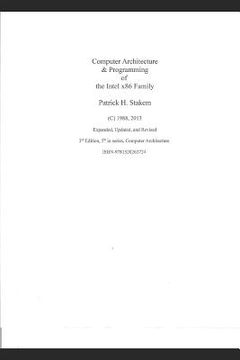Reseña del libro "Computer Architecture & Programming of the Intel X86 Family (en Inglés)"
This book is an introduction to computer architecture, hardware and software, presented in the context of the Intel x86 family. The x86 describes not only a line of microprocessor chips dating back to 1978, but also an instruction set architecture (ISA) that the chips implement. The chip families were built by Intel and other manufacturers, and execute the same instructions, but in different manners. The results are the same, arithmetically and logically, but may differ in their timing. Why the focus on the Intel x86? It was the basis of the IBM personal computer (PC) family and its spin-offs. It has transitioned from a 16 to a 32 to a 64-bit architecture, keeping compatibility for more than 30 years. It's an de-facto industry standard that has withstood the test of time. This book covers the Intel ISA-16 and ISA-32 architectures from the 8086/8088 to the Pentium, including the math coprocessors. A chart of ISA processors is included. The purpose of this book is to provide the basic background information for an understanding of the 80x86 family, the IBM Personal Computer (pc), and programming in assembly language as an introduction to the broader field of Computer Architecture. It will stress the pervasiveness of this pc-based technology in everyday things and events. It will provide an introduction to Software System Engineering and the Design for Debugging methodology. This book is a spin-off of a course in Computer Architecture/System Integration, taught in the graduate Engineering Science Program at Loyola College (now, Loyola University in Maryland). If we learn to program in the language c, for example, we can take our skills to any computer with a set of c-based tools. If we learn IA-32 assembly language, we have to relearn a language if we switch to a different architecture. So, why do we learn assembly language? Because it gives us insight into the underlying hardware, how it is organized, and how it operates. This book is dedicated to the graduate students in Engineering Science at Loyola College, Columbia Campus, who took the course EG-611, "System Integration I, the x86 Architecture and Assembly Language." The course was given to hundreds of students over a span of 15 years by myself and others. An Extensive bibliography is provided. Table of Contents Introduction Definitions Technological & Economic Impact Limitations of the technology Number Systems Computer Instruction Set Architecture Prefixes Position notation Infinities, overflows, and underflows Hexadecimal numbers Elementary Math operations Base conversion Logical operations on data Math in terms of logic functions Negative numbers Data structures Integers BCD Format ASCII Format Parity Lists Hardware Elements of a Computer The Central Processing Unit The fetch/execute cycle X86 Processor family Input/Output I/O Methods Polled I/O Interrupt DMA Serial versus parallel Memory Memory organization and addressing Caches Memory Management Software Elements of a Computer Instruction Set Architecture (ISA) of the 80x86 Family Programmers model of the x86 Assembly Language The compilation process Operating system: what it is; what it does The Intel x86 instruction set Stack Protocols Basic Math Operations Logical operations BCD Operations 64 Operations on STRINGS of data Shifts/rotates Multiply Divide Faster Math Interrupt architecture Pseudo operations Labels Addressing modes on the 8086 Effective Address Calculation Memory Segments Code addressing modes Data Addressing Modes Program Flow Subroutines Macro Modular design X86 Boot sequence The 8086 reset The BIOS ROM CPUid instruction Load

